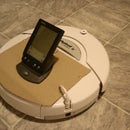Introduction: SNES to Parallel Port
The basic steps to modify your SNES controller to connect to your computer via the parallel port.
Step 1: Strip SNES Controller Cable
Strip the end of the SNES (Super Nintendo Entertainment System) controller cable (the end that connects to the SNES), and tin the ends of the wires. If you don't want to cut up your controller you can just stick wires in the end that plugs into the SNES according to the diagram in step 3.
Alternatively (what I did), you could replace the SNES cable with one from something else, that way you don't need to chop up the controller. In my case I had a broken NES controller that I borrowed a cord from. It is also recommended that instead of cutting the cable you get a SNES controller extension cable and cut that up. In either case the steps are the same.
Alternatively (what I did), you could replace the SNES cable with one from something else, that way you don't need to chop up the controller. In my case I had a broken NES controller that I borrowed a cord from. It is also recommended that instead of cutting the cable you get a SNES controller extension cable and cut that up. In either case the steps are the same.
Step 2: Powering the Controller
There are several ways to power the controller. The cleanest way is to draw power directly from the parallel port with diodes. You can also get power from the USB port or from an extra power cable inside of the computer (if you aren't using a laptop).
To draw power from the parallel port attach a diode to pins 4-9 on the parallel port connector according to the diagram below. The +5V end attaches to the white wire on the controller (make shore that the diodes are aligned correctly, the black stripe should point away from the parallel port).
Otherwise you can strip a spare USB cable and attach the controller's power (white) wire to the red 5V wire on the USB cable and the ground (brown) wire on the controller to the black/ground wire in the USB cable.
To draw power from the parallel port attach a diode to pins 4-9 on the parallel port connector according to the diagram below. The +5V end attaches to the white wire on the controller (make shore that the diodes are aligned correctly, the black stripe should point away from the parallel port).
Otherwise you can strip a spare USB cable and attach the controller's power (white) wire to the red 5V wire on the USB cable and the ground (brown) wire on the controller to the black/ground wire in the USB cable.
Step 3: Attach Everything Else
The yellow/clock wire connects to pin 2, the orange/latch wire connects to pin 3, the red/data wire connects to pin 10, and the brown/ground wire connects to pin 18 (if you are powering trough the parallel port).
Step 4: Install Software
You can find windows XP/2000 (PPJoy) drivers here: http://www.simtel.net/product.php?id=75176
PPJoy has fairly good documentation, including instructions on using different interfaces (the Playstation or Sega Genesis controllers for example). But here is generally what you need to do.
After installing PPJoy go to the control panel and click on the icon labeled "Parallel port Joysticks". In the new window click on the button labeled "Add...".
In the "Configure new controller" window set "Parallel port" to "LPT1", "Controller type" to "SNES or NES pad", "Interface type" to "DirectPad Pro/SNESkey", "Controller number" to "Controller 1", and "Controller sub type" to "SNES or Virtual Gameboy".
Hit "Add" and let windows install the drivers.
PPJoy has fairly good documentation, including instructions on using different interfaces (the Playstation or Sega Genesis controllers for example). But here is generally what you need to do.
After installing PPJoy go to the control panel and click on the icon labeled "Parallel port Joysticks". In the new window click on the button labeled "Add...".
In the "Configure new controller" window set "Parallel port" to "LPT1", "Controller type" to "SNES or NES pad", "Interface type" to "DirectPad Pro/SNESkey", "Controller number" to "Controller 1", and "Controller sub type" to "SNES or Virtual Gameboy".
Hit "Add" and let windows install the drivers.
Step 5: Clean Up
Any your done _. You can configure your controller like any joystick/game pad in Control Panel - Game Controllers. This setup will work with pretty much all SNES/NES emulators, adding a level of authenticity a keyboard could never provide. And it functions like a regular game pad that you would buy in the store.




![[Idea] Air Mouse](https://content.instructables.com/FMI/YVU7/8DYEP27YGAT/FMIYVU78DYEP27YGAT.bmp?auto=webp&crop=1%3A1&frame=1&width=130)